check engine AUDI S3 2015 Owner's Manual
[x] Cancel search | Manufacturer: AUDI, Model Year: 2015, Model line: S3, Model: AUDI S3 2015Pages: 310, PDF Size: 76.15 MB
Page 218 of 310
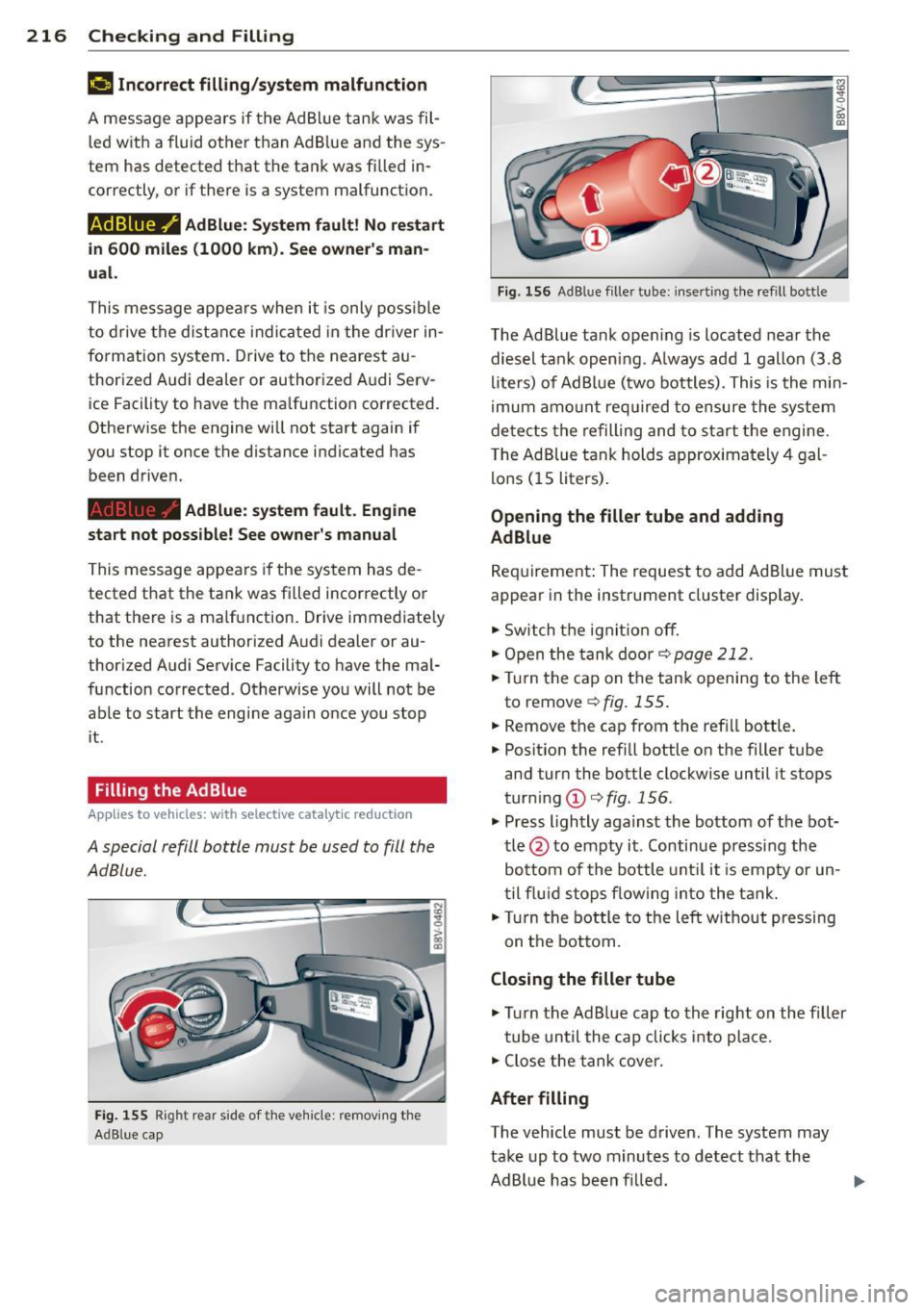
216 Checking and Filling
¢..ij Incorrect filling /sy stem malfunction
A message ap pears if the Ad Bl ue tank was fil
l ed with a fluid other t han Ad B lue and the sys
tem has detected t hat the tank was fi lled in
correctly, or if the re is a system malfunction .
Ad Blue/ Ad Blue: Sy stem fault! No re start
in 600 miles (1000 km ). See owner' s man
ual.
This message appears whe n it is only poss ible
to drive the distance i ndi cated in the dr iver in
formation system. Drive to the neares t au
thorized A udi dealer or author ized A udi Se rv
ice Facility to have the ma lfunction co rrected.
Otherwise the engine will not start again if
you stop it once the distance i nd icated has
been drive n.
AdBlue: system fault . Engine
start not possible! See owner 's manual
This message appears if the system has de
tected t hat the ta nk was fi lled incorrectly or
that the re is a ma lfunction . Drive immediate ly
to the nearest authorized A udi dealer or au
thor ized Audi Serv ice Facility to have the ma l
function corrected . Otherwise you will not be
ab le to start the engine aga in o nce you stop
it .
Filling the Ad Blue
App lies to vehicles: with selective cata lyt ic reduction
A special refill bottle must be used to fill the
AdBlue .
Fig. 155 R ig ht re ar s id e of th e v ehi cle: re mov ing the
Ad Blue cap
F ig . 1 56 AdBl ue f ille r tube: i nse rtin g the ref ill bottl e
The Ad Blue tank ope ning is located near the
di ese l ta nk open ing . A lways ad d 1 gallon (3.8
li te rs) of AdB lue ( two bottles). This is the min
i mum amo unt req uired to ensure the system
de te ct s the refilling and to s tart the engine .
T he Ad Blue tank holds approximately
4 gal
lo ns
(1 5 liters) .
Opening the filler tube and adding
AdBlue
Req uirement : The request to add Ad Blue mus t
appea r in the instrument cluster disp lay.
" Switch th e ignit io n off.
.. Open the tank door¢
page 212.
.. Tur n the cap on the tank opening to the left
to remove
¢ fig . 155 .
.. Remove the cap from the ref ill bott le.
.. Posit ion the refill bottle on the filler tube
and tur n the bottle clockwise until it stops
turn ing (D ¢fig .156 .
" Press lightly aga inst the bottom of the bot
tle @to empty it . Continue pressing the
bo ttom of the bottle unt il it is empty or un
t il f lu id stop s flow ing in to the ta nk.
" Turn the bottle to t he left w it h out pressing
on t he bot tom.
Closing the filler tube
" Tur n the Ad B lue cap to the right on the filler
t ube until the cap clicks into pla ce.
" Clo se the tank cover.
After filling
The vehicle must be driven. The system may
ta ke up to two m inutes to detect that the
AdBl ue has been f illed . .,.
Page 219 of 310
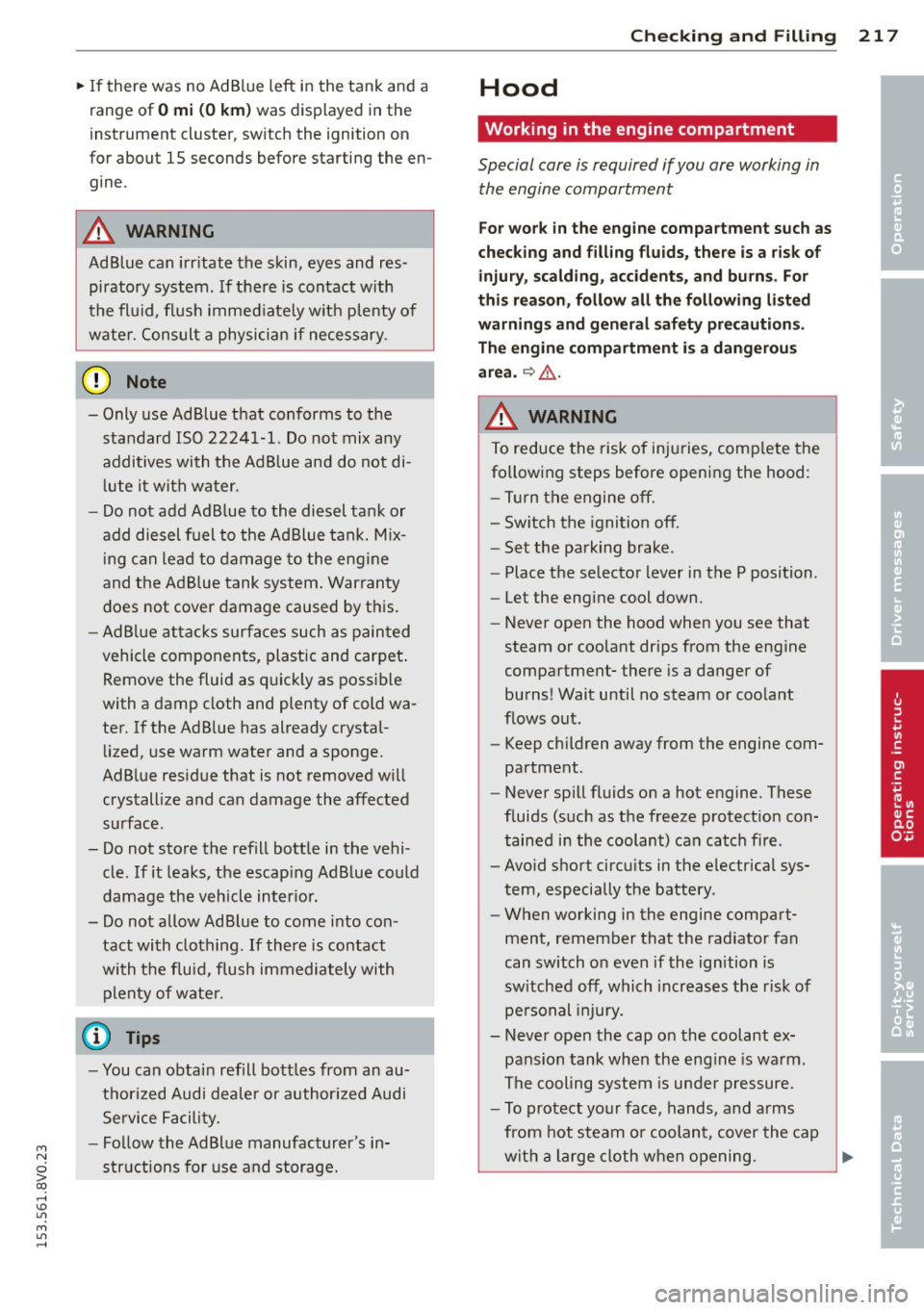
M N
0 > co ,...., \!) 1.1"1
M 1.1"1 ,....,
~ If there was no Ad Blue left in the tank and a
range of
O mi (0 km) was displayed in the
instrument cluster, switch the ignition on
for about 15 seconds before starting the en gine.
_& WARNING
Ad Blue can irritate the skin, eyes and respiratory system. If there is contact with
the fluid, flush immediately with plenty of
water. Consult a physician if necessary.
(D Note
- Only use Ad Blue that conforms to the standard ISO 22241-1. Do not mix any
additives with the Ad Blue and do not dilute it with water .
- Do not add Ad Blue to the diesel tank or
add diesel fuel to the Ad Blue tank. Mix
ing can lead to damage to the engine
and the Ad Blue tank system. Warranty
does not cover damage caused by this.
- AdBlue attacks surfaces such as painted
vehicle components, plastic and carpet.
Remove the fluid as quickly as possible
with a damp cloth and plenty of cold wa
ter. If the Ad Blue has already crystal lized, use warm water and a sponge .
AdBlue residue that is not removed will
crystallize and can damage the affected
surface .
- Do not store the refill bottle in the vehi cle. If it leaks, the escaping Ad Blue could
damage the vehicle interior.
- Do not allow AdBlue to come into con
tact with clothing . If there is contact
with the fluid, flush immediately with
plenty of water.
@ Tips
- You can obtain refill bottles from an au
thorized Audi dealer or authorized Audi
Service Facility.
- Follow the AdBlue manufacturer's in
structions for use and storage.
Checking and Filling 217
Hood
Working in the engine compartment
Special care is required if you are working in
the engine compartment
For work in the engine compartment such as
checking and filling fluids, there is a risk of
injury, scalding, accidents, and burns. For
this reason, follow all the following listed
warnings and general safety precautions.
The engine compartment is a dangerous
area.
c::> .&. .
_8 WARNING
To reduce the risk of injuries, complete the
following steps before opening the hood:
- Turn the engine off.
- Switch the ignition off.
- Set the parking brake.
- Place the selector lever in the P position.
- Let the engine cool down.
- Never open the hood when you see that
steam or coolant drips from the engine
compartment- there is a danger of burns! Wait until no steam or coolant
flows out .
- Keep children away from the engine com
partment.
- Never spill fluids on a hot engine . These
fluids (such as the freeze protection con
tained in the coolant) can catch fire .
- Avoid short circuits in the electrical sys
tem, especially the battery .
- When working in the engine compart
ment, remember that the radiator fan
can switch on even if the ignition is
switched off, which increases the risk of
personal injury.
- Never open the cap on the coolant ex
pansion tank when the engine is warm.
The cooling system is under pressure.
- To protect your face, hands, and arms
from hot steam or coolant, cover the cap
with a large cloth when opening.
II>-
•
•
•
Page 220 of 310
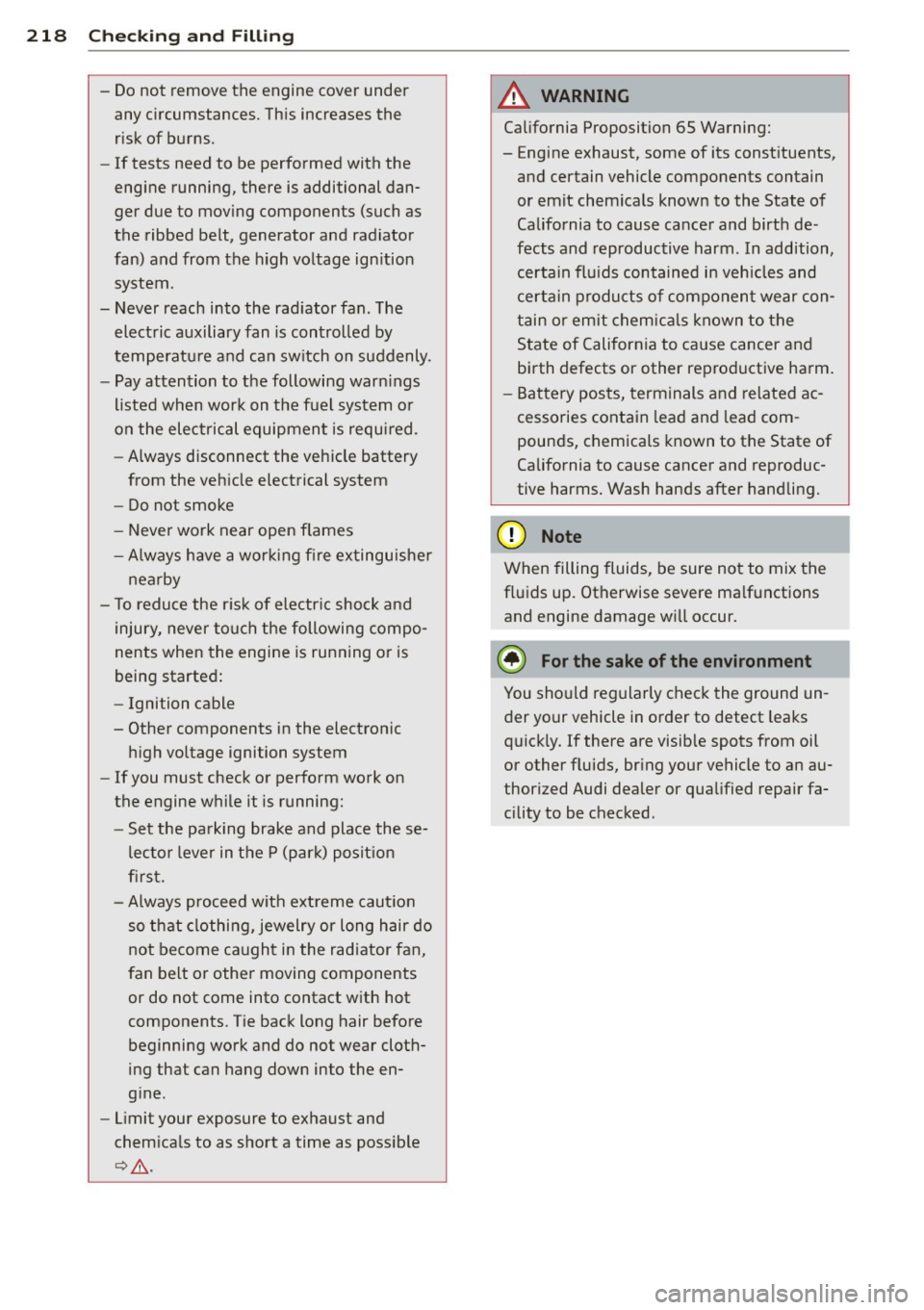
218 Check ing and F illin g
- Do not remove the engine cover under
any circumstances. Th is increases the
risk of burns.
- If tests need to be performed with the
engine running, there is additional dan
ger due to moving components (such as
the ribbed belt, generator and radiator
fan) and from the high voltage ign ition
system .
- Never reach into the rad iator fan . The
electric auxiliary fan is controlled by
tempe ratu re and can sw itch on suddenly.
- Pay attention to the following warn ings
listed wh en work on the fue l system or
on the electrical equipment is required.
- Always disconnect the vehicle battery
from the vehicle electrical system
- Do not smoke
- Never work near open flames
- Always have a working fire extinguisher
nearby
- To reduce the r isk of electric sho ck a nd
injury, never touch the following compo
nents when the engine is running or is
being started:
- Ignition cable
- Other components in the electronic
h igh voltage ignition system
- If you must check or perform work on
the engine while it is running:
- Set the parking brake and place these
lector lever in the P (park) posit ion
first.
- Always proceed with ext reme caut ion
so that clothing, jewelry or long hair do not become ca ugh t in the radiator fan,
fan belt o r other moving components
or do not come into contact with hot
components . Tie back long hair before
beginning work and do not wear cloth
ing that can hang down into the en
g ine.
- Limit your exposure to exhaust and
chemica ls to as short a time as poss ible
~ .&. -
A WARNING
Ca lifornia Proposition 6S Warning:
- Engine exhaust, some of its constituents,
and certain vehicle components contain
or emit chemicals known to the State of
California to cause cancer and birth de
fects and reproductive harm. In addition,
certa in flu ids contained i n veh icles and
certain products o f componen t wear con
tain or emit chemic als known to t he
State of California to ca use cancer and
birth defects or other reproductive ha rm .
- Battery posts, terminals and related ac
cessories contain lead and lead com
pounds, chemicals known to the State of
California to cause cancer and reproduc
tive harms. Wash hands after handling.
(D Note
When filling fluids, be sure not to mix the
fl ui ds up . Otherwise severe ma lf u nctions
and engine damage w ill occur.
@ For the sake of the environment
You sho uld reg ularly chec k the ground un
der your vehicle in order to detect leaks
quick ly. If there are visib le spots from oil
or other fluids, br ing your vehicle to an au
thorized Audi dealer or qua lified repair fa
cility to be checked .
Page 221 of 310
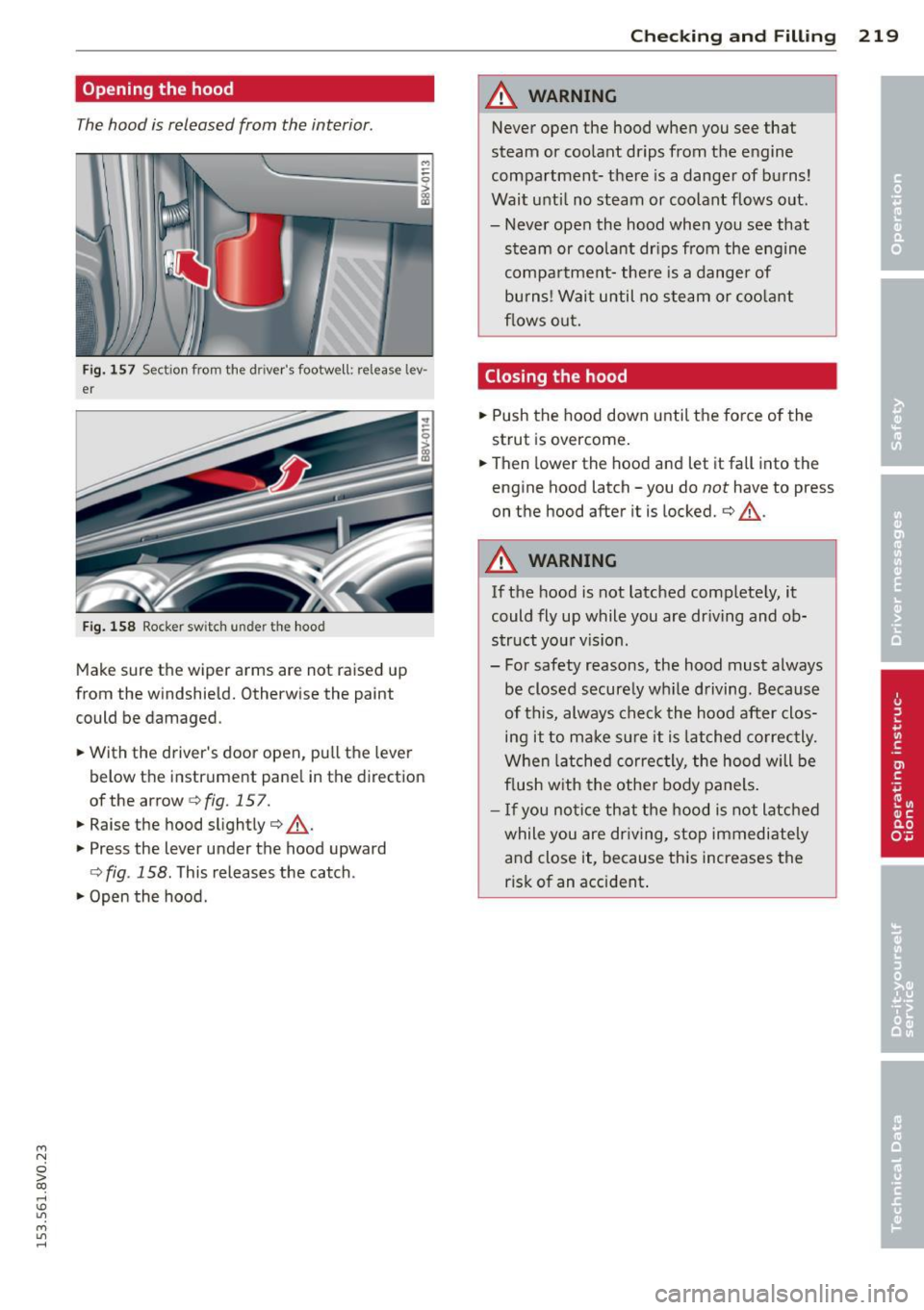
....,
N
0 > co
rl I.O
"' ....,
"' rl
Opening the hood
The hood is released from the interior.
Fig. 157 Sect ion from the driver's footwe ll: release lev·
er
F ig. 158 Rocker switch un de r the hood
Make sure the wiper arms are not raised up
from the windshield. Otherwise the paint
could be damaged.
• With the driver's door open, pu ll the lever
below the instrument pane l in the direction
of the arrow
¢ fig. 157.
• Raise the hood slightly c;, &_ .
• Press the lever under the hood upward
c;, fig . 158. This releases the catch .
• Open the hood .
Che cking and Fillin g 219
A WARNING
Never open the hood when you see that
steam or coo lant drips from t he e ngine
compartment· there is a danger of burns!
Wait unti l no steam or coolant flows o ut.
- Never open the hood when you see that
steam or coo lant dr ips from the engine
compa rtment- the re is a dange r of
bu rns! Wai t until no ste am or coo lan t
flows o ut.
Closing the hood
• Push the hood down unti l the fo rce of the
strut is overcome .
• Then lower the hood and let it fall into the
engine hood latch -you do
not have to press
on the hood after it is locked.
c;, &_ .
A WARNING
If the hood is not latched complete ly, it
could fly up while you are dr iv ing and ob
struct you r vis io n.
- For safety reasons, the hood must always
be closed secure ly wh ile d riving. Because
of this, always check the hood after clos
ing it to make sure it is lat ched co rrectly.
When latched correc tly, the hood will be
f lush w ith the othe r body panels .
-If you no tic e th at t he hood is not latched
while you are dr iving, stop immedi ately
and close it, because this increases the
ris k of an accident .
Page 222 of 310
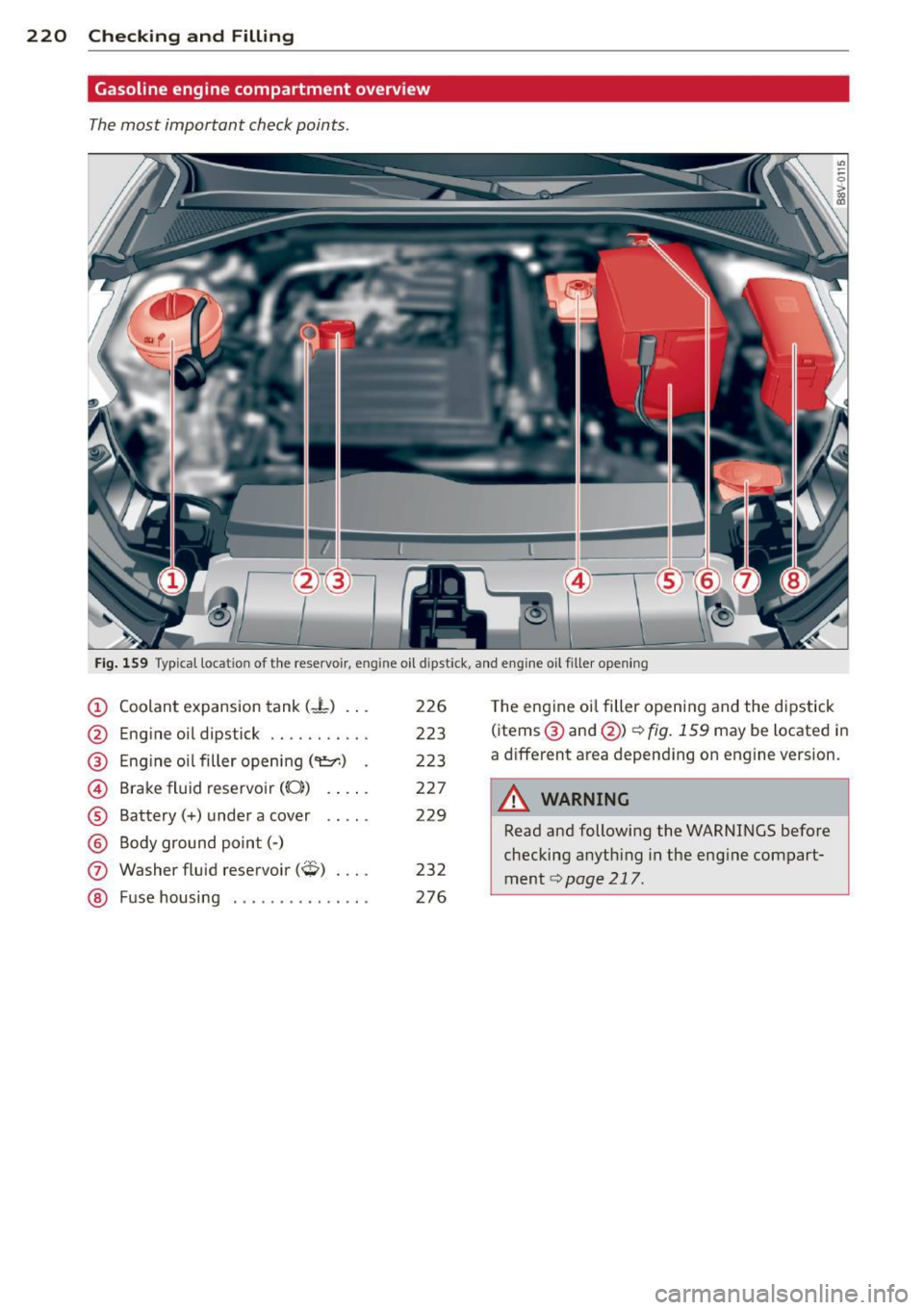
220 Checking and Filling
Gasoline engine compartment overview
The most important check points.
Fig. 159 Typical locat ion of th e reservo ir, engine oi l d ipstick, and engine oil filler opening
CD Coolant expansion tank ( ... L) ... 226 The eng ine oi l filler opening and the d ipstick
@ Engine oil dipstick
...........
223 (items® and @)¢ fig. 159 may be located in
® E
ngine oi l filler open ing
('t=r.) 223 a different area depending on engine version.
© Brake fluid reservoir ((0) .. .. . 227 A WARNING
® Battery(+) under a cover 229 .. ... -
® Body ground point(-) Read
and following the WARNINGS before
checking anyth ing in the eng ine com part-
(j) Washer fluid reservoir(<$) . ... 232 ment ¢ page 217.
® Fuse housing ............. .. 276
Page 223 of 310
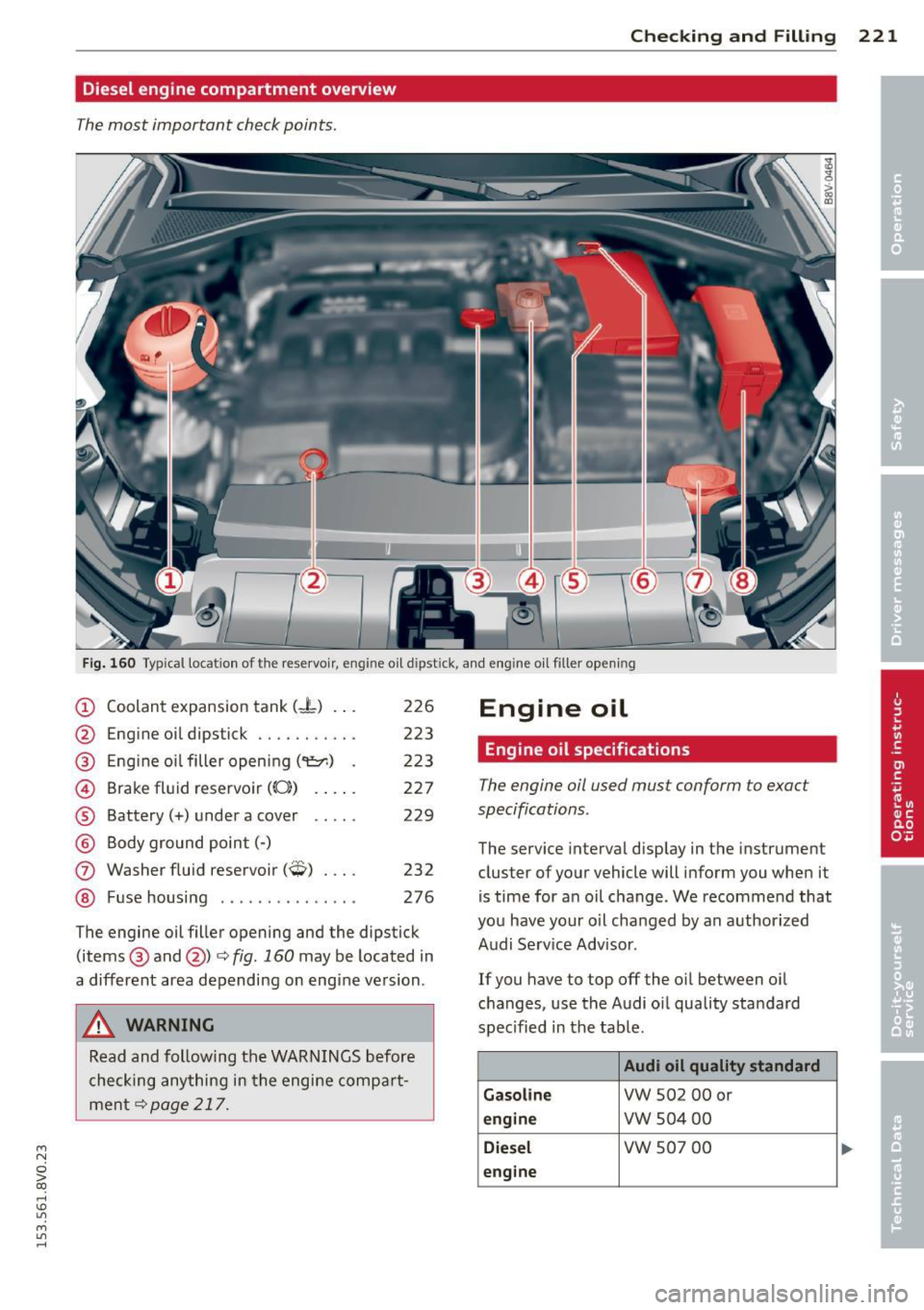
....,
N
0 > co
rl I.O
"' ....,
"' rl
Checking and Fillin g 221
Diesel engine compartment overview
The most important check points .
Fig. 160 Typical locat ion of th e reservo ir, engine oil dip stick, and engine oil filler opening
(D Coolant expansion tank (J-) .. .
@
®
©
®
®
0
®
Eng ine oi l dipstick .......... .
E ng ine o il filler opening
('!=r.) .
Brake fluid reservoir ((0))
Battery(+) under a cover .....
B ody ground point(-)
Washer f luid reservoir(~)
F use housing .............. .
226
223
223
227
229
232
276
The engine oil filler opening and the dipstick
(items @ and @)¢
fig. 160 may be located in
a different area depending on eng ine ve rsion .
A WARNING
Read and following the WARN INGS before
checking anything in the engine compa rt
ment
¢page 217.
Engine oil
Engine oil specifications
The engine oil used must conform to exact
specifications .
The service interva l disp lay in the instrument
cluster of yo ur vehicle will inform you when it
is time for a n oil change . We recomme nd that
you have your oil changed by an author ized
Audi Se rv ice Advisor .
If you have to top off the o il between oi l
c hanges, use the Audi o il quality sta ndard
spec ified in the tab le .
Audi oil quality standard
Gasoline
VW 502 00 or
engine vw 504 00
Diesel vw 507 00
eng ine
...
Page 224 of 310
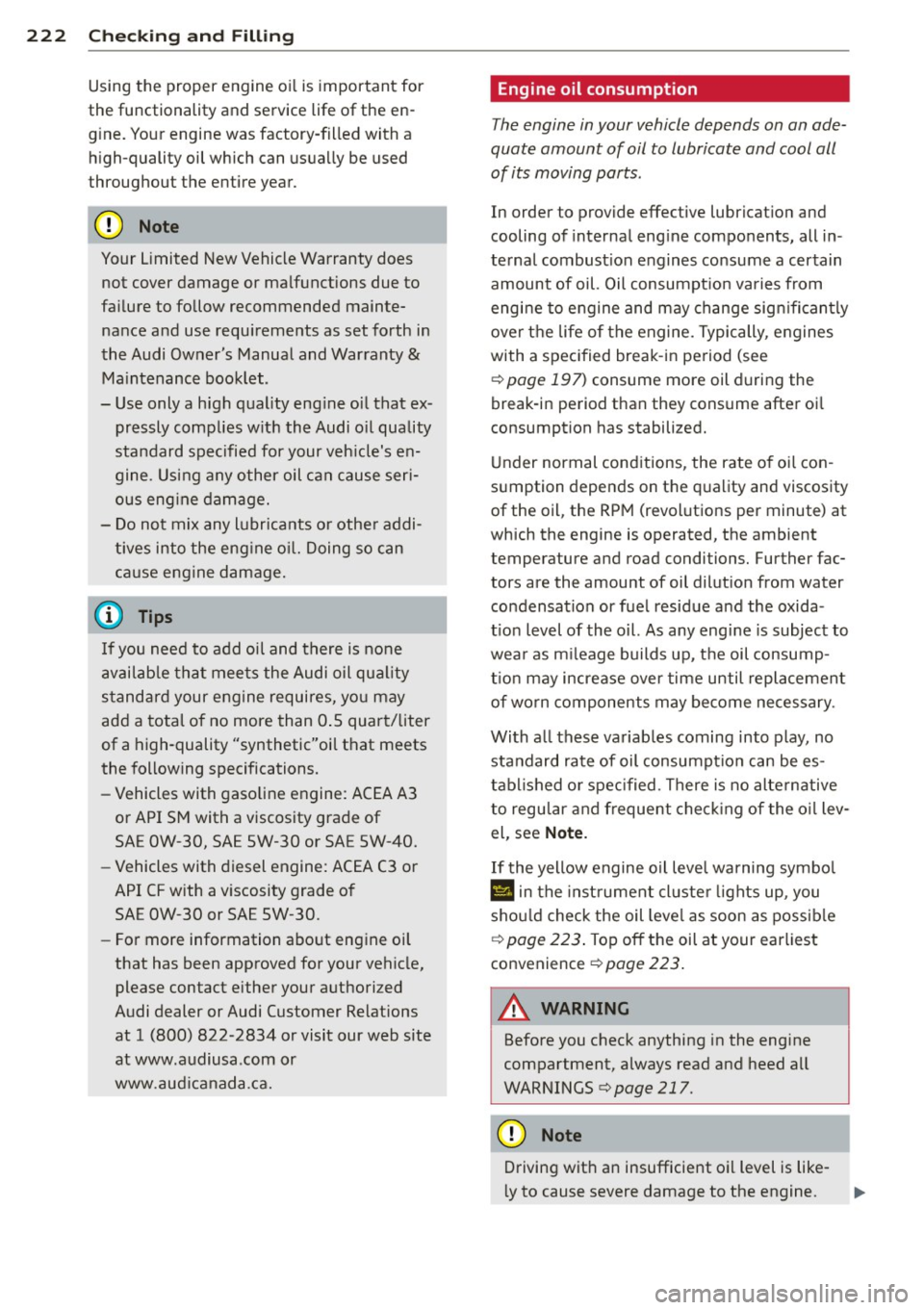
222 Check ing and F illin g
Using the proper engine o il is important for
the functionality and service life of the en
g ine. Your engine was factory-filled with a
high-quality oil which can usua lly be used
throughout the entire year.
0 Note
Your L imited New Vehicle Warranty does
not cover damage or ma lfunctions due to
fai lure to follow recommended mainte
nance and use requ irements as set forth in
the Audi Owner's Manual and Warranty
&
Ma intenance booklet.
- Use only a high quality eng ine oil that ex
pressly complies w ith the Audi o il quality
standard spec ified for your veh icle's en
gine. Using any other oil can cause seri
ous eng ine damage.
- Do not mix any lubricants o r othe r addi
tives into the eng ine o il. Doing so can
ca use engine damage.
If you need to add oi l and there is no ne
availab le tha t mee ts the Audi oil qua lity
s tandard your engine requires, yo u may
add a tota l of no more than 0 .5 quart/liter
of a high-quality "synthetic"oil that meets
the following specifications.
- Vehicles with gaso line engine: ACEA A3
or API SM with a viscosity grade of
SAE 0W-30, SAE SW-30 or SAE SW-40.
- Vehicles with diesel engine: ACEA C3 or
API CF with a v iscosity grade of
SAE 0W-30 or SAE SW-30.
- For more information abo ut eng ine oil
that has been approved for your vehicle, please contact either your a uthorized
Audi dealer or Audi Customer Relations
at 1 (800) 822-2834 or visit our web site
at www.audiusa .com or
www.aud icanada.ca.
Engine oil consumption
The engine in your vehicle depends on on ade
quate amount of oil to lubricate and cool all
of its moving ports .
In order to provide effective lubricat ion and
cooling of interna l eng ine components, all in
ternal combust ion e ngines consume a certain
amount of oil. Oil consumpt ion va ries from
engi ne to engine and may change sig nifican tly
over the life of the engine. Typically, engines
with a spec ified break -in period (see
¢ page 197) consume more oil during the
break-in period than they cons ume after oi l
consumption has stabilized.
U nder normal cond itions, the rate o f oi l con
s u mption depends on the q uality and viscos ity
of the oil, the RPM (revolutions per minute) at
which the engine is operated, the ambient
temperature and road conditions. Further fac
tors are the amount of oil dilut ion from water
condensation or fue l residue a nd the oxida
t ion level of the oil. As any eng ine is subject to
wea r as m ileage builds up, t he oil co nsump
t ion may increase over time until replacemen t
of worn components may be come necessary.
With a ll these variab les coming into play, no
standard rate of oil consumpt io n can be es
tabl ished o r spe cified . There i s no alte rnative
to regu lar and frequent che ck ing of the o il lev
el , see
Note.
If the yellow engine oil leve l wa rning symbo l
Ill in the inst rument cl uste r lights up, you
sho uld check the oil leve l as soon as possib le
i=> page 223 . Top off the oil at your earliest
convenience
i=> page 223 .
A WARNING
--
Before you check anything in the engine
compartment, always read and heed a ll
WARNINGS¢ page 217.
(D Note
Driving wit h an insufficient o il level is like -
l y to cause severe damage to the engine.
liJJ,
Page 225 of 310
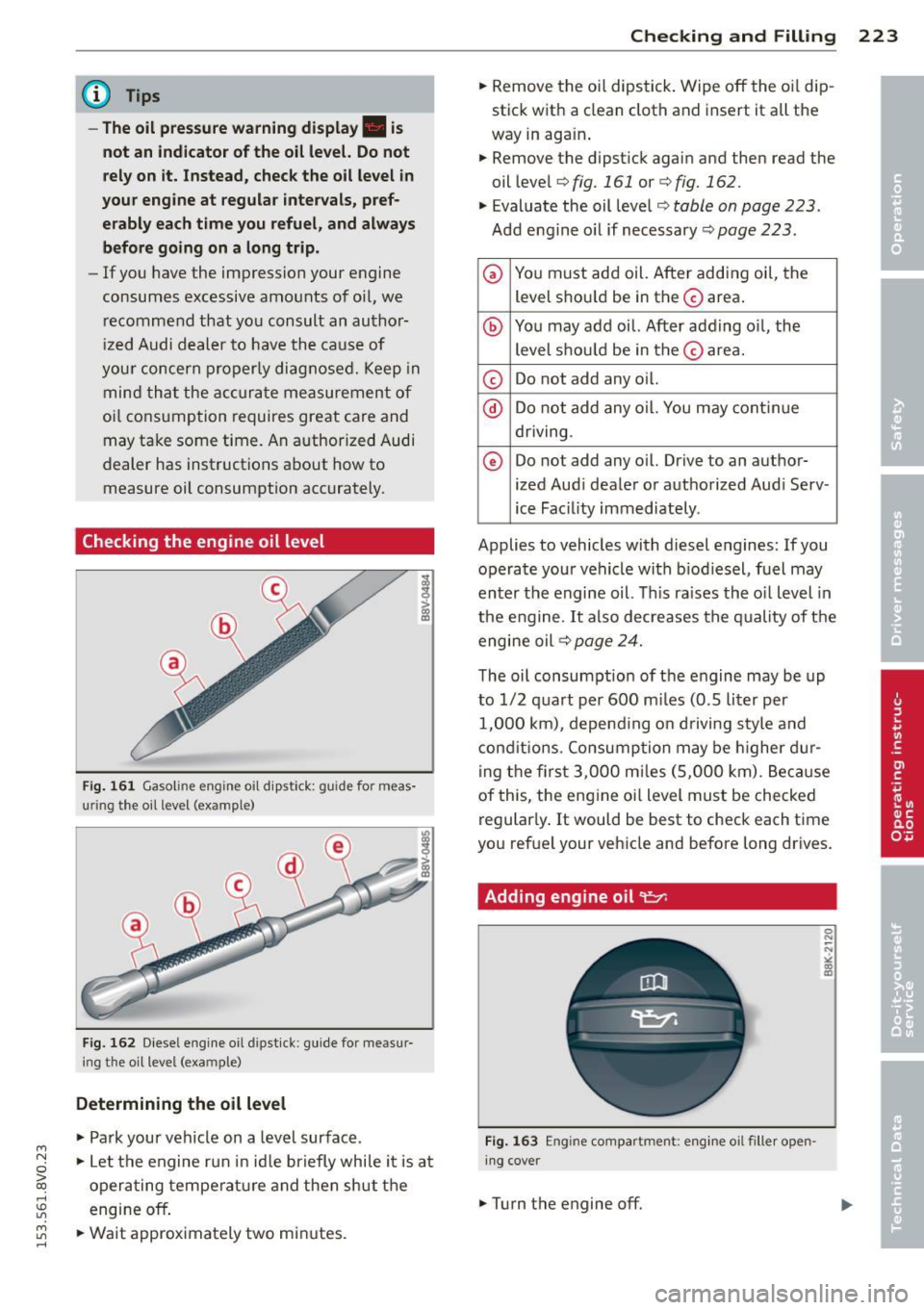
....,
N
0 > co
rl I.O
"' ....,
"' rl
@ Tips
- The oil pre ssure wa rning display. i s
not an indicator of the o il level. Do not
rely on it. Instead , chec k the oil le vel in
your engine at regular inter vals, pref
era bly each t ime you r efuel , and always
before going on a long trip .
-If you have the impression your engine
consumes excessive amounts of oi l, we
r ecommend that you consult an author
iz ed Audi dealer to have the cause of
you r concern properly di ag nose d. Keep in
mind tha t the ac curate measuremen t of
oi l consumption requires great care and
may take some time. An authorized Audi
dealer has instructions about how to measure oil consumption accurately.
Checking the engin e oil lev el
Fi g. 1 61 Ga so line e ngine oil d ip sti ck: guide for meas
urin g the oil level (ex ample)
F ig . 162 Diese l e ngine oil dipstick : guide for m easur
i ng the o il leve l (exa mple)
Determining the oil level
• Pa rk your vehicle on a level surface .
• Let the engine run in id le briefly while it is a t
opera ting temperat ure and then shut the
engi ne off .
• Wa it approximately two mi nutes .
Che cking and Fillin g 223
• Remove the oi l dipstick . Wipe off the oi l dip
stick with a clean cloth and insert it all the
way in aga in .
• Remove the dipstick again and then read the
oil level ¢
fig. 161 or¢ fig. 162 .
• Evaluate the oil level¢ table on page 223 .
Add e ngine o il if necessary ¢ page 223.
0 You must add o il. After add ing oil, the
level shou ld be in the @ area .
® You may add oil. After adding o il, the
level s hou ld be in the@area.
@ Do not add any o
il.
@ Do not add any o il. You may cont inue
driving .
0 Do not add any o il. Drive to an author-
ized Aud i dealer or authorized Aud i Serv -
ice Fac ility immediately .
Applies to vehicles with diesel engines: If you
operate your vehicle with b iod iesel, fuel may
enter the engine oil. T his ra ises the o il level in
the engine.
It also decreases the quality of t he
engine oil¢
page 24.
The oil consumptio n of the engine may be up
to 1/2 q uart per 600 m iles (0.5 liter per
1,000 km), depend ing on d riving style and
cond it io ns. Consump tion may be higher du r
ing the first 3,000 m iles (5,000 km) . Be ca u se
of this, the eng ine oi l level must be checked
regular ly . It would be best to check each time
you ref uel your vehicle and before long dr ives.
Adding engine oil~
Fig . 1 63 En gin e co mpar tment: e ng in e o il fi ller ope n
ing cover
• Turn the engine off.
0 N
~ a, a,
Page 226 of 310
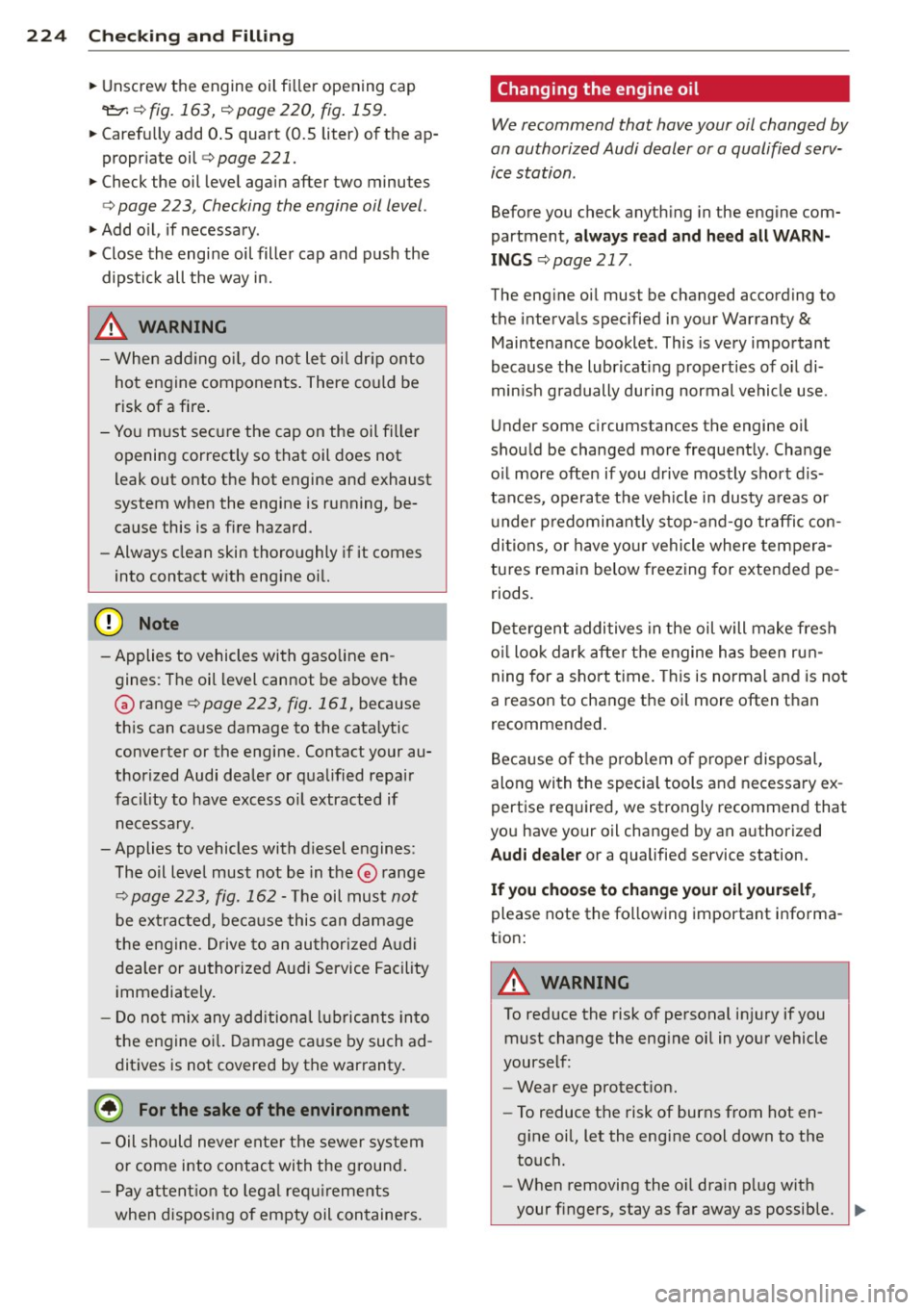
224 Check ing and F illin g
• Unscrew the engine oil fi ller opening cap
~ ¢ fig. 163, ¢page 220, fig . 159.
• Carefu lly add 0 .5 quart (0.5 liter) of the ap
propr iate oil¢
page 221.
• Check the oil level again after two minutes
¢ page 223, Checking the engine oil level.
• Add o il, if necessary .
• Close the engine oil filler cap and push the
dipstick all the way in.
.&_ WARNING
- When add ing o il, do not le t oi l dr ip onto
hot engine components . There could be
risk of a fire .
- You must sec ure the cap on the oil filler
opening correctly so that oil does not
leak out onto the hot engine and exhaust
system when the engine is running, be
cause this is a fire hazard.
- Always clean skin thoroughly if it comes
into contact w ith eng ine oil.
([) Note
- Applies to vehicles with gasoline en
gines: The oil level cannot be above the
(!) range¢
page 223, fig. 161, because
th is can ca use damage to the cata lytic
converter or the engine. Contact your au
thorized Audi dealer or qua lified repair
facil ity to have excess o il extracted if
necessary.
-Applies to vehicles with diesel engines: The oil level must not be in the
0 range
¢
page 223, fig. 162 -The oil must not
be extracted, because this can damage
the engine. Drive to an au thorized A udi
dealer or authorized A udi Service Facility
immediately.
- Do not mix any additiona l lubricants into
the engine o il. Damage cause by such ad
ditives is not covered by the war ranty.
@) For the sake of the environment
- Oil should never enter the sewer system
or come into contact with the ground .
- Pay a tte ntion to leg al req uirements
when disposing of empty oil containers .
Changing the engine oil
We recommend that have your oil changed by
an authorized Audi dealer or a qualified serv
ice station.
Before you check anyth ing in the engine com
partment,
always read and h eed all WARN
INGS
¢ page 217.
The engine oil must be changed according to
the interva ls specified in your Warranty
&
Maintenance booklet . This is very important
because the lubricat ing propert ies of o il di
min ish g radually du ring normal vehicle use.
Under some circumstances the engine oil
should be changed more frequently. Change o il more often if you drive mostly short d is
tances, operate the ve hicle in dusty a reas or
under p redo min ant ly stop-and-go traffic con
di tions, or have yo ur vehicle where tempera
tures remain below freezing for extended pe
riods .
De te rgent additives in the oil will make fresh
o il look dark after the engine has been run
ning for a sho rt time. This is normal and is not
a reason to change the oil more often than
recommended.
Beca use of the p roblem of proper disposal,
along wi th the specia l tools and necessary ex
pertise req uired, we st rongly recommend that
you have your oil changed by an a uthorized
Audi deale r or a qualified service station.
If you choo se to chan ge your oil your self ,
please note the fo llowing important informa
tion:
.&_ WARNING
To reduce the risk of personal in jury if you
must change the eng ine oil in your vehicle
yourself:
- Wear eye protect ion.
- To reduce the risk of burns from hot en-
g ine oi l, let the engine cool down to the
touch.
- When removing the o il drain p lug with
your fingers, stay as far away as possible. ..,
Page 227 of 310
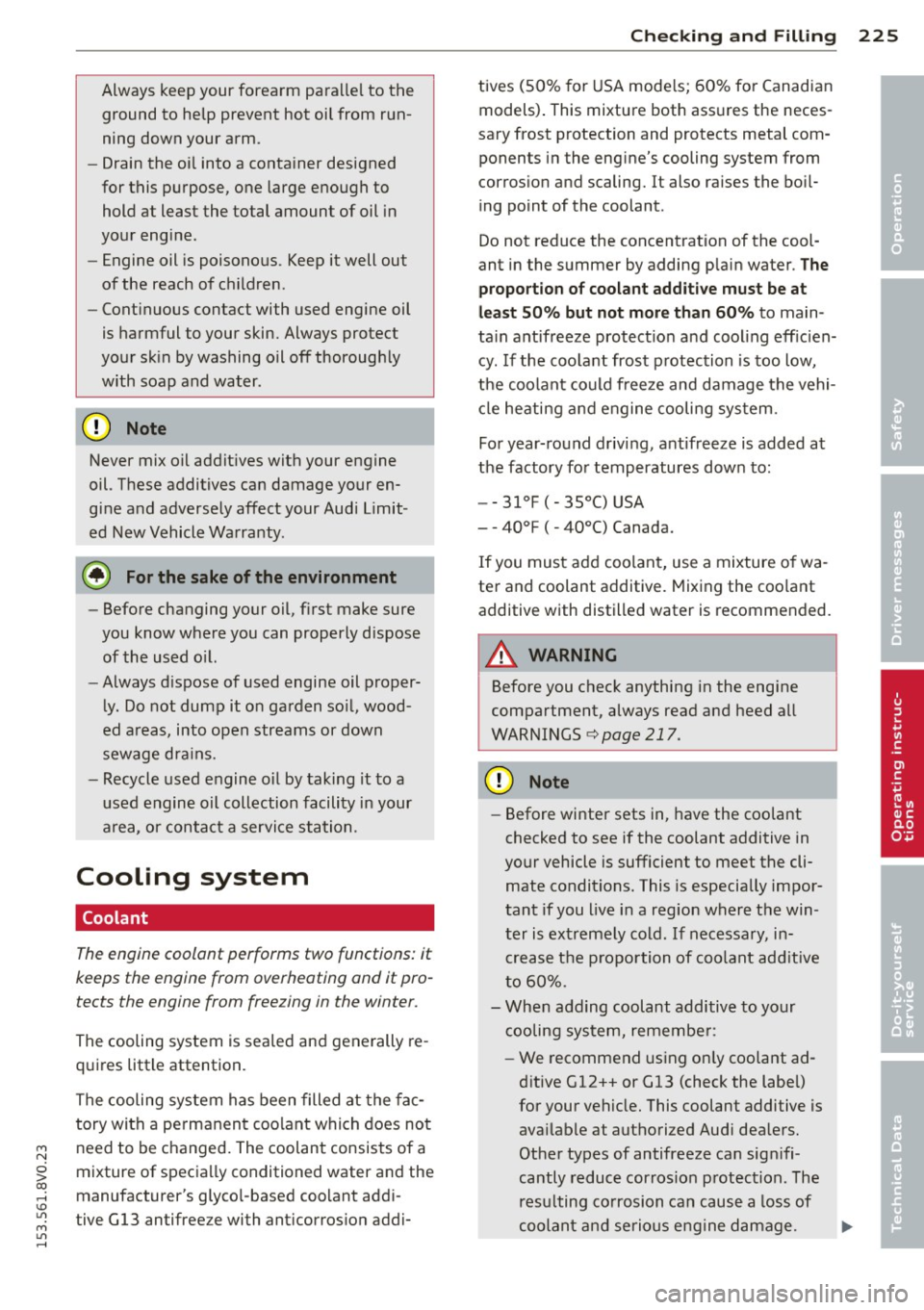
M N
0 > co ,...., \!) 1.1"1
M 1.1"1 ,....,
Always keep your forearm parallel to the
ground to help prevent hot oil from run
ning down your arm.
- Drain the oi l into a conta iner designed
for this p urpose, one large eno ugh to
hold at least the total amount of oil in
your engi ne.
- Engine oil is poisono us. Keep it well out
of the reach of c hildren .
- Cont inuo us contact with used engine oil
is harmful to your skin. Always protect
you r sk in by washing oil off thoroug hly
with soap and water .
(D Note
Never mix oil addit ives with your engine
oil. These additives can damage your en
gine and adversely affect y our Aud i Limit
ed New Vehicle Wa rra nty .
@ For the sake of the environment
- Before changing your oi l, f irst make sure
you know whe re you can proper ly dispose
of the used o il.
- Always d ispose of used engine oil proper
l y. Do not dum p it o n ga rden so il, wood
ed a reas, into open streams or down
sewage dra ins.
- Recycle used engine o il by taking it to a
u se d engine oil collection facility in your
a rea, or contact a servi ce station .
Cooling system
Coolant
The engine coolant performs two functions: it
keeps the engine from overheating and it pro
tects the engine from freezing in the winter.
The cooling system is sea led an d generally re
q uir es little attention.
The cooling system has been filled at the f ac
tory with a pe rm anen t coo lan t which does no t
n eed to be changed. The coolant consists of a
mixture of specia lly conditioned water and the
manufacturer's glyco l-based coo lant add i-
tive Gl3 antifree ze with ant icorros ion addi-
Checking and Fillin g 225
tives (50% for USA mode ls; 60% fo r Canadian
models) . This mixture both ass ures the neces
sary frost protection and protects metal com
ponents in the eng ine's cooling system from
corros io n and scaling. It also raises the bo il
ing point of the coolant .
Do not reduce the concentration of the cool
ant in the s ummer by adding p lain water.
The
proportion of coolant additive must be at
least 50°/o but not more than 60 %
to main
ta in antifreeze protect io n and cool ing eff ic ien
cy . If the coo lant frost p rotection is too low ,
t he coo lan t could freeze and damage the vehi
cl e heating and engine cooling sys tem.
Fo r year- round drivi ng, a ntifreeze is added at
the factory fo r temperatures down to:
- -31 °F
< -3s0c) u sA
- -40°F ( - 40°C) Canada.
If you must ad d coo lant, use a mixture o f wa
te r and coolant additive. Mixing the coo lant
additive with dist illed water is recommended.
A WARNING
Before you chec k anything in the engine
compartment, always read and heed all
WARNI NGS
c:> page 217.
-
(D Note
- Before winter sets in, have the coo lant
checked to see if the coolant additive in
your vehicle is sufficient to meet the cli mate condit ions. This is especially impor
t ant if you l ive i n a region where the win-
t er is extremely cold. If necessary, in-
c rea se t he p ropo rtion of coo lant add itive
t o 6 0% .
- Whe n ad d ing coolant addi tiv e to yo ur
c ooling sys te m , reme mbe r:
- We recommend using on ly coo lant ad
d itive Gl2 ++ or Gl3 (check the labe l)
for your vehicle. This coolant additive is ava ila ble at autho rized Aud i dea le rs .
Othe r ty pes of antifreeze ca n sig nifi
cantly reduce cor ros io n protec tion . The
r esu lting co rrosion can cause a lo ss of
c o o lant a nd serio us e ng ine da mage.
IJI,,
•
•
•